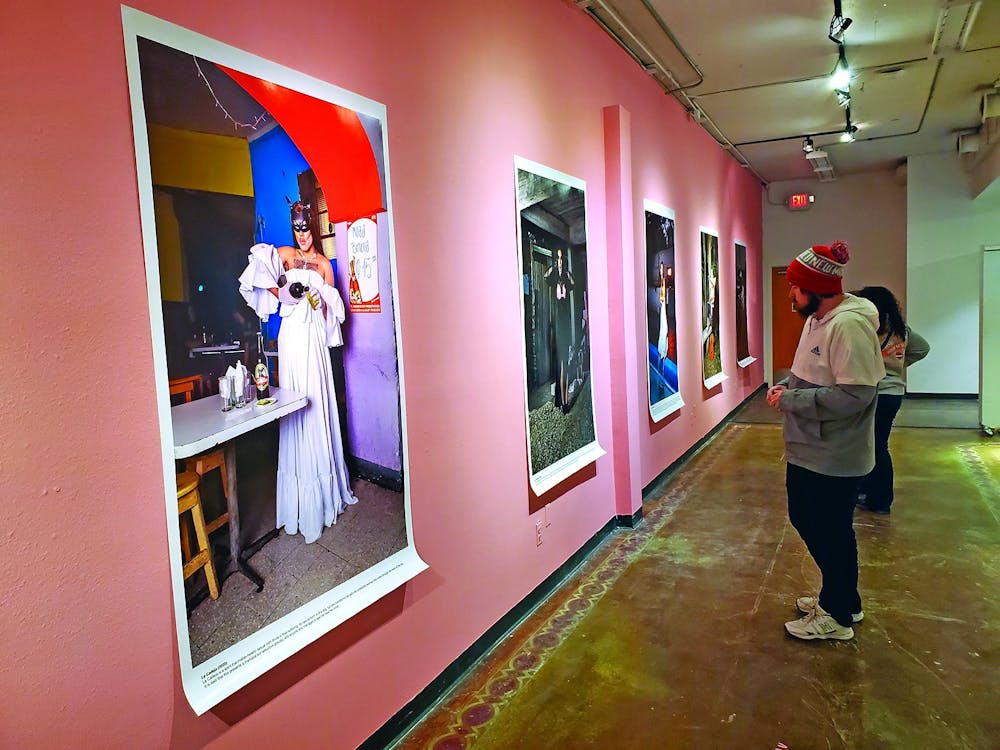DOWNTOWN, ABQ — Martin Wannam's thesis show "La Eterna Resistencia" examined the sociopolitical system in Guatemala through a queer, brown lens with content based off of religious narratives and normative societal ideologies.
Wannam's work manifests itself through large-scale prints hung from the walls of the Center for Fine Arts Downtown Studio. The prints showed queer men and women from Guatemala dressed as folklore legends, both from South America and Wannam's own imagination.
"I started taking Guatemalan legends and queering them out," Wannam said. "I would change their narrative and change the way they're perceived as queer."
Hanging on one of the walls of the studio was the work of a Guatemalan piñata maker who made replicas of seven people who died either in U.S. Immigration and Customs Enforcement custody or by crossing the border.
Wannam said he wanted to play with the narrative of living the American dream, showing that it can be complex and dangerous for some who have to trek long distances in difficult conditions to reach that dream.
"A lot of people, including myself, we try to migrate to different places because there's no opportunities or source of understanding that we can do better," Wannam said. "It's kind of ironic — like this is the American dream, but people are being killed by the system of the state."
Wannam also showed a video of himself doing a street performance piece in front of the Guatemalan National Palace with the Guatemalan national anthem playing in the background. During the video, someone comes to Wannam and carves the word Hueco, a pejorative Spanish term for homosexual, onto his back.
He said he wanted to take a political stance for those who are being called the derogatory term.
"A lot of hate crimes in 2019 were subjected to not only killing, but carving on those that are that terminology as a way of saying, 'Yo, they're killing us but the state doesn't recognize it,'" Wannam said.
Diana Macias, a graduate student in the biology department, said what stood out to her the most was the wheelbarrow of waxed pink bananas on top of banana leaves. The bananas also had a symbol of Christ on them.
Macias said she thought the bananas represented the way in which the United Fruit Company has created a lot of violence and genocide in Guatemala so that Americans can have this very affordable fruit available all the time.
"It comes at a cost. The really low prices (are) actually a hidden cost of the pain, suffering and violence that it causes," Macias said. "I think that having the wax sculpture of Christ on top of these bananas is kind of a parallel in the way that religion was used to colonize Guatemala and Latin America in general."
Get content from The Daily Lobo delivered to your inbox
Macias said she thought the artist was trying to draw parallels between the way which religion and corporations have taken advantage of people and created pain and suffering in these communities.
She also said she came to the event not knowing much about what it's like to be queer and a person of color in Guatemala, but thought the exhibit would give her a way to learn about those unfamiliar narratives.
"I think this exhibit does a really good job of showing how it is to be queer and express your gender," Macias said. "Also, there's this whole side of the exhibit where there's all these myths that have been queered, so at the same time the artist is showing a utopia or a world in which he can imagine what it would be like to be queer in Guatemala."
Amanda Britt is the photo editor at the Daily Lobo. She can be contacted at photoeditor@dailylobo.com or on Twitter @AmandaBritt__






